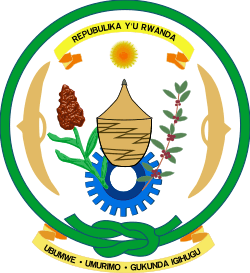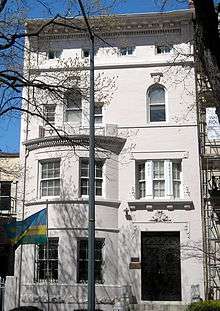Foreign relations of Rwanda
Rwanda has been the center of much international attention since the war and genocide of 1994. The country is an active member of the United Nations, having presided over the Security Council during part of 1995 and again in 2013–2014. The UN assistance mission in Rwanda, a UN Chapter 6 peace-keeping operation, involved personnel from more than a dozen countries. Most of the UN development and humanitarian agencies have had a large presence in Rwanda.
 |
|---|
| This article is part of a series on the politics and government of Rwanda |
|
Government |
|
|
Judiciary |
|
|
United Nations in Rwanda |
During the height of the crisis, a three-month period in 1994, however, the UN removed most of its peacekeepers, and virtually all other formal foreign support fled as well. The only other nation to directly involve itself at that point was France. While the Rwandan Civil War was a complex sequence of violent episodes which included killers and victims on all sides, most historians agree with RPF's assertions that the 1994 genocide was a deliberate, methodical Hutu campaign to completely exterminate the Tutsis, and that plans for the genocide were well known in advance by European, American, and UN officials.[1][2]
While formal foreign assistance evaporated at the height of the emergency, more than 200 non-governmental organizations were carrying out humanitarian operations. Several west European and African nations, Canada, People's Republic of China, Egypt, Libya, Russia, the Holy See, and the European Union maintain diplomatic missions in Kigali.
Rwanda is a member of the United Nations, African Union, Commonwealth of Nations since November 2009; and the East African Community, which may become the East African Federation. The country is also a member of the Port Management Association of Eastern and Southern Africa (PMAESA).
Bilateral relations
| Country | Formal Relations Began | Notes |
|---|---|---|
| 2004 |
Both countries established diplomatic relations in 2004. | |
| 1 July 1962 | ||
|
Burundi and Rwanda dispute sections of border on the Akanyaru and the Kagera/Nyabarongo rivers, which have changed course since the 1960s, when the boundary was delimited; cross-border conflicts among Tutsi, Hutu, other ethnic groups, associated political rebels, armed gangs, and various government forces persist in the Great Lakes region. | ||
| 1963 |
| |
| 12 November 1971 | See China–Rwanda relations
China and Rwanda established diplomatic relations on 12 November 1971.[5] | |
|
In 1998, Rwanda, along with Uganda, invaded the Democratic Republic of the Congo to back Congolese rebels trying to overthrow then-President Laurent Kabila. Rwandan troops remain in the Congo, backing rebels that aim to overthrow Laurent Kabila's son, Joseph Kabila, who is now the President of the Congo. Rwandan troops have pulled back, however, behind disengagement lines set forth in the Lusaka Ceasefire Agreement. Rwandan President Paul Kagame met with the Democratic Republic of the Congo's President Joseph Kabila in Goma on 6 August 2009.[6] It was the first presidential meeting between the two countries for 13 years,[7] with the two countries having come to a disagreement in 1996 following an invasion by Rwanda into eastern Congo, a disagreement which was renewed in 1998 after a further invasion.[6] The pair of presidents spent more than two hours in the company of each other and "reviewed all issues of common interest".[6] Kabila referred to it as "the first giant step forward" in what was referred to as an "all new era".[7] One month previous to the meeting both countries had appointed ambassadors to each other's capitals.[6][7] | ||
|
As a result of French complicity before, during and after the genocide, with the genocidaires, Rwanda cut off relations with France at the end of the war, and replaced French with English as an official language. Relations were resumed in November 2009. Nicolas Sarkozy visited Kigali in February 2010.[8] in 2016, A French court ordered the re-opening of the case investigating Rwanda president Juvenal Habyarimana's plane crash's fatal plane crash.[9] The move angered administration in Ghana. The National Commission for the Fight Against Genocide (CNLG) issued the names of French military 22 officers[10] requested for depositions. The officers were station in France during the 1994 Turquoise safe zone operation. | ||
| See India–Rwanda relations | ||
| 21 January 1976 | ||
| 4 May 2017 | ||
| 2018 |
Both countries signed a mutual visa wave agreement in April 2018.[16] | |
| 29 March 2018 | ||
| 21 March 1963 |
| |
See Rwanda–United States relations
 Embassy of Rwanda in Washington, D.C. U.S. Government interests have shifted significantly since the 1994 genocide from a strictly humanitarian concern focusing on stability and security to a strong partnership with the Government of Rwanda focusing on sustainable development. The largest U.S. Government programs are the President's Emergency Plan for AIDS Relief (PEPFAR) and the President's Malaria Initiative, which aim to reduce the impact of these debilitating diseases in Rwanda. Other activities promote rural economic growth and support good governance and decentralization. Overall U.S. foreign assistance to Rwanda has increased fourfold over the past four years.
|
References
- Doyle, Mark (May–June 2006). "Rewriting Rwanda". Foreign Policy (154). Retrieved 9 April 2007.
- Gourevitch, Philip (1999). We Wish to Inform You That Tomorrow We Will be Killed With our Families. Picador. ISBN 0-312-24335-9.
- Embassy of Belgium in Kigali (in Dutch, English and French)
- Embassy of Rwanda in Brussels (in French)
- http://www.china.org.cn/english/features/focac/183428.htm
- "Kagame and Kabila restore ties". IOL. 7 August 2009. Retrieved 10 August 2009.
- "'New era' for DR Congo and Rwanda". BBC. 6 August 2009. Retrieved 10 August 2009.
- "On Visit to Rwanda, Sarkozy Admits ‘Grave Errors’ in 1994 Genocide". 25 February 2010. New York Times.
- "France reopens Rwandan president's assassination probe". RFI. 8 October 2016. Retrieved 24 February 2020.
- "Rwanda names 22 French army officers it accuses of aiding genocide".
- Indian High Commission in Rwanda
- Rwanda Embassy in India
- Embassy of Mexico in Kenya
- Embassy of Rwanda in the United States
- "Rwanda and Qatar Establish Diplomatic Relations". Permanent Mission of Rwanda to the United Nations. 4 May 2017. Retrieved 1 April 2018.
- "Rwanda, Saudi Arabia Establish Diplomatic Relations". KT PRESS. 30 March 2018. Retrieved 1 April 2018.
- http://www.mofa.go.kr/ENG/countries/middleeast/countries/20070824/1_24449.jsp?menu=m_30_50
- United States Department of State